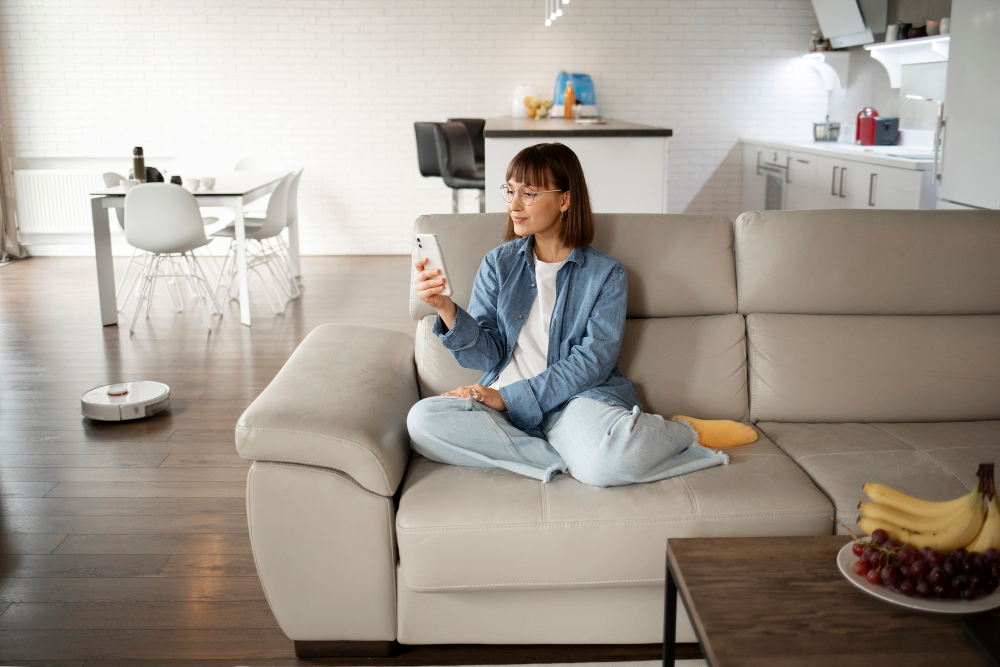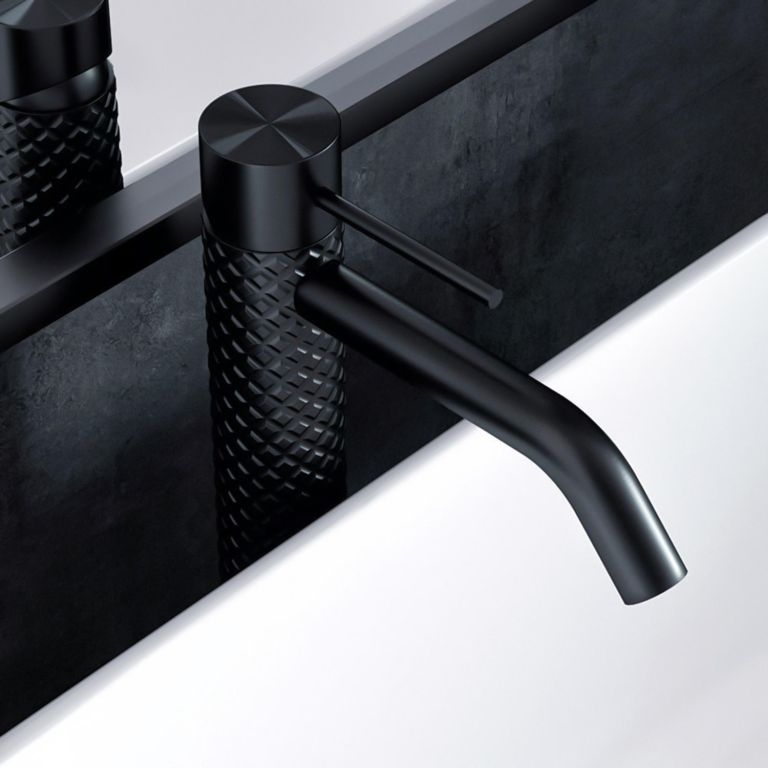Looking at the “before” photos of the 650 square foot San Francisco condo I redesigned last year, you’d never believe it now houses a couple, their home offices, a guest room, and everything they need to entertain eight people for dinner.
The transformation didn’t involve knocking down walls or adding square footage. Instead, we used every vertical inch, built furniture that serves multiple purposes, and created sightlines that make the space feel twice its actual size.
When the owners moved from a 2,000 square foot suburban home to this Mission District condo, they thought they’d have to sacrifice comfort and functionality. Instead, they discovered that thoughtful design can make small spaces feel more functional and livable than many larger homes.
This project captures the reality facing thousands of Bay Area residents: rising housing costs have made compact living not just a choice, but often a necessity. The median home price in San Francisco exceeds $1.3 million, pushing many families and professionals into condos, apartments, and smaller homes that require creative design solutions.
After completing over 250 small space renovations across the Bay Area, I’ve learned that successful compact living isn’t about doing without – it’s about doing more with less through intelligent design, multi-functional solutions, and strategic visual tricks that create the illusion of spaciousness.
The homes that work best feel organized, uncluttered, and surprisingly spacious despite their modest square footage. Every element serves multiple purposes, storage is hidden but accessible, and clever design makes small spaces feel larger than their measurements suggest.
Let me show you exactly how to transform compact Bay Area spaces into functional, beautiful homes that feel generous rather than cramped.
Understanding the Bay Area Small Space Challenge
Bay Area housing costs have fundamentally changed how we live, pushing more families into smaller spaces that require innovative design solutions to remain comfortable and functional.
The economics are stark: purchasing power for housing has declined 40% over the past decade, meaning families who once could afford 2,000+ square foot homes now look at 800-1,200 square foot condos and apartments.
The New Reality of Compact Living
Financial drivers reshaping Bay Area housing:
Housing cost pressure: Median home prices ranging from $800,000 in East Bay to $1.8 million in Peninsula create pressure to maximize smaller spaces
Rental market dynamics: Average rent for one-bedroom apartments exceeding $3,000 in many areas drives demand for efficient space utilization
Lifestyle shifts: Work-from-home requirements, multigenerational living, and urban convenience preferences influencing space needs
Design opportunity: Smaller spaces that function well often feel more comfortable and organized than larger spaces with poor planning
Common Small Space Challenges
Storage inadequacy: Typical small homes lack sufficient closet and storage space for modern living requirements
Multi-functional needs: Spaces must serve multiple purposes – living room becomes office, dining room becomes craft space, bedroom becomes guest room
Visual cramping: Poor furniture selection and placement can make small spaces feel claustrophobic rather than cozy
Privacy limitations: Open floor plans in small spaces can lack quiet retreat areas for concentration or relaxation
Entertaining constraints: Difficulty hosting family and friends in meaningful ways
Multi-Functional Furniture Solutions
The foundation of successful small space design is furniture that works harder – pieces that serve multiple functions while maintaining style and comfort.
Murphy Beds and Sleep Solutions
Modern Murphy bed systems have evolved far beyond basic fold-down beds to become sophisticated furniture pieces that transform rooms instantly.
Contemporary Murphy bed applications:
Office-guest room combinations:
- Horizontal Murphy beds: Fold down from custom wall units that include desk space and storage
- Vertical systems: Traditional fold-down design with integrated shelving and lighting
- Cost range: $2,500-8,000 for quality systems with custom cabinetry
- Space savings: Convert 120 sq ft office into functional guest room in 30 seconds
Living room-bedroom dual use:
- Sofa-bed wall units: Murphy beds that reveal sofa when folded up
- Entertainment integration: TV and media storage combined with sleeping area
- Lighting coordination: Integrated reading lights and ambient lighting for both functions
Children’s room optimization:
- Bunk bed alternatives: Murphy beds that create play space during day
- Study area integration: Desk space that appears when bed is folded up
- Storage maximization: Drawers and shelving integrated into bed wall unit
Installation considerations:
- Structural requirements: Proper wall reinforcement for bed weight
- Ceiling height needs: Minimum 8’6″ ceiling for comfortable vertical systems
- Professional installation: Critical for safety and smooth operation
Convertible Desks and Work Surfaces
Work-from-home requirements in compact spaces demand furniture that transforms spaces for different functions throughout the day.
Fold-out desk systems:
Wall-mounted options:
- Drop-down desks: Fold against wall when not in use, minimize space intrusion
- Secretary desk style: Traditional furniture appearance with modern functionality
- Kitchen integration: Breakfast bar that extends for laptop work
- Cost range: $800-3,500 depending on size and customization
Dining table work stations:
- Height-adjustable tables: Standard dining height converts to standing desk height
- Extension systems: Tables that expand for work materials, contract for dining
- Storage integration: Built-in drawers for office supplies and table linens
Mobile work solutions:
- Rolling carts: Office supplies and laptop storage that wheels to different rooms
- Laptop stands: Adjustable height stands that work over sofas, beds, or dining tables
- Nesting desk sets: Multiple work surfaces that stack when not needed
Expandable and Nesting Furniture
Furniture that grows and shrinks based on need provides maximum flexibility in small spaces.
Expandable dining solutions:
Console to dining table:
- Butterfly leaf systems: Narrow console tables that expand to seat 6-8 people
- Drop-leaf designs: Wall-mounted tables that fold completely flat
- Telescoping tables: Tables that extend in length for different group sizes
Nesting table systems:
- Coffee table sets: Multiple surfaces that nest under main table
- Side table collections: Various heights and sizes that stack efficiently
- Ottoman storage: Ottomans that provide seating, storage, and surface area
Modular seating:
- Sectional systems: Pieces that reconfigure for different room layouts
- Storage ottomans: Seating that opens for blanket and pillow storage
- Bench seating: Storage benches that work for dining, entryway, or bedroom
Vertical Storage Solutions
When floor space is limited, successful small space design must utilize vertical space efficiently while maintaining visual appeal and accessibility.
Floor-to-Ceiling Shelving Systems
Maximizing wall space with properly designed storage creates dramatic increases in storage capacity without consuming floor area.
Custom built-in strategies:
Living room wall systems:
- Entertainment integration: TV, sound system, and storage in single wall unit
- Book and display storage: Adjustable shelving for varying object sizes
- Hidden storage: Closed cabinets for items that don’t display well
- Lighting integration: LED strips that illuminate contents and create ambiance
Kitchen vertical storage:
- Pantry wall systems: Floor-to-ceiling food storage with pull-out organizers
- Appliance storage: Vertical slots for baking sheets, cutting boards, platters
- Spice and small item organization: Narrow pull-out drawers and carousel systems
- Upper cabinet extensions: Cabinets that reach ceiling with step-stool access
Bedroom storage walls:
- Wardrobe systems: Custom closets that maximize hanging and folding space
- Seasonal storage: High shelves for items used infrequently
- Display and personal items: Combination of open and closed storage
Installation considerations:
- Structural mounting: Proper anchoring to wall studs for safety
- Accessibility planning: Frequently used items at eye level
- Visual balance: Mixing open and closed storage for aesthetic appeal
- Cost range: $150-400 per linear foot for custom built-in systems
Loft and Mezzanine Solutions
High ceilings in small spaces create opportunities for adding functional square footage through elevated areas.
Loft bed applications:
Adult loft systems:
- Office space below: Full desk and filing area under elevated bed
- Living area below: Seating and entertainment space under sleeping area
- Storage integration: Stairs with built-in drawers and closet space
- Safety considerations: Proper railing height and ladder/stair design
Mezzanine level creation:
- Reading nooks: Elevated spaces for quiet activities
- Storage lofts: High-level storage accessible by ladder
- Guest sleeping: Occasional use sleeping areas that don’t consume main floor space
Structural requirements:
- Ceiling height needs: Minimum 10-12 feet for comfortable loft installation
- Building code compliance: Proper headroom, egress, and ventilation
- Professional engineering: Structural analysis for load-bearing capacity
Creative Storage Integration
Finding storage in unexpected places maximizes capacity while maintaining clean, uncluttered appearance.
Under-stair utilization:
- Pull-out drawers: Custom drawer systems that utilize triangular space
- Wine storage: Climate-controlled wine storage in cool under-stair areas
- Closet creation: Small but functional closets for coats, cleaning supplies, or pantry
Furniture-integrated storage:
- Platform beds: Bed frames with extensive drawer and compartment storage
- Window seat storage: Built-in seating with storage underneath
- Stair storage: Drawers built into stair risers
Hidden storage systems:
- False walls: Shallow storage behind wall-mounted TV or artwork
- Floor storage: Raised platform flooring with storage underneath
- Ceiling storage: Overhead compartments for seasonal or rarely used items
Creating the Illusion of Space
Visual tricks and design strategies can make small spaces feel dramatically larger through strategic use of color, light, reflection, and sightlines.
Light Colors and Reflection Strategies
Light colors and reflective surfaces multiply natural light and create sense of openness that extends apparent room boundaries.
Color palette optimization:
Wall color strategies:
- Light neutrals: Whites, creams, and pale grays that reflect maximum light
- Cool tones: Soft blues and greens that visually recede and feel spacious
- Monochromatic schemes: Single color family in varying shades creates visual continuity
- Accent color placement: Dark colors only on single accent walls or small elements
Ceiling color techniques:
- White or lighter than walls: Creates illusion of higher ceilings
- Continuous color: Same color on walls and ceiling eliminates visual breaks
- Gloss levels: Eggshell or satin finishes reflect more light than flat paint
Floor color coordination:
- Light flooring: Blonde woods, light tile, or pale carpeting expand space visually
- Continuous materials: Same flooring throughout eliminates visual breaks
- Large format tiles: Reduces grout lines and creates expansive appearance
Mirror and Glass Applications
Strategic mirror and glass placement can visually double space while adding light and creating interesting design elements.
Mirror placement strategies:
Opposite window placement:
- Function: Reflects natural light and outdoor views throughout space
- Size considerations: Large mirrors create more dramatic effect than small ones
- Frame selection: Minimal or no frames maintain clean appearance
Corner mirror installations:
- Space multiplication: Corner mirrors create illusion of extended room depth
- Safety considerations: Proper mounting and shatter-resistant materials
- Integration: Mirrors that feel intentional rather than obvious space tricks
Mirrored furniture and surfaces:
- Coffee tables: Glass or mirrored tops that don’t visually consume floor space
- Cabinet doors: Mirrored cabinet fronts in kitchens and bathrooms
- Backsplashes: Mirrored kitchen backsplashes that reflect light and activity
Glass partition solutions:
- Room division: Glass walls that separate spaces without blocking light
- Shower enclosures: Clear glass showers that don’t visually shrink bathrooms
- Interior windows: Glass panels between rooms that share light
Open Floor Plan Optimization
Removing walls and creating open sight lines maximizes apparent space while maintaining necessary functional areas.
Wall removal strategies:
- Load-bearing analysis: Professional structural evaluation before wall removal
- Kitchen-living integration: Opening kitchens to living areas for social cooking
- Dining area integration: Flexible dining spaces that serve multiple functions
Sight line management:
- Clear pathways: Furniture arrangement that creates unobstructed views
- Consistent sight lines: Aligning elements to create visual continuity
- View termination: Strategic placement of art or features at sight line ends
Functional zoning without walls:
- Furniture placement: Using furniture to define areas without walls
- Rug definition: Area rugs that create visual boundaries between functions
- Lighting zones: Different lighting for different functional areas
- Level changes: Subtle platform or step changes to define spaces
Small Kitchen and Bathroom Solutions
Kitchens and bathrooms present unique challenges in small spaces due to plumbing, appliance, and storage requirements that can’t be easily moved or eliminated.
Compact Kitchen Design Strategies
Small kitchens must maximize every inch while maintaining full functionality for cooking, storage, and cleanup.
Galley kitchen optimization:
Efficient layout principles:
- Work triangle optimization: Sink, stove, and refrigerator placement for efficient movement
- Counter space maximization: Every inch of counter surface planned for specific functions
- Appliance integration: Built-in appliances that don’t protrude into walkway space
- Vertical storage: Upper cabinets that extend to ceiling with step-stool access
Space-saving appliance selection:
- Compact dishwashers: 18-inch dishwashers that fit into small spaces
- Counter-depth refrigerators: Refrigerators that don’t extend beyond counter depth
- Combination appliances: Microwave-convection ovens, washer-dryer combos
- Induction cooktops: Compact cooking surfaces that don’t require ventilation space
Storage innovation:
- Pull-out organizers: Drawers that bring back-of-cabinet items to front
- Vertical dividers: Storage for baking sheets, cutting boards, and platters
- Door-mounted storage: Spice racks, cleaning supplies, and small items on cabinet doors
- Ceiling-mounted pot racks: Overhead storage that doesn’t consume cabinet space
Small Bathroom Design Solutions
Bathroom renovations in small spaces require creative solutions for storage, privacy, and functionality within tight constraints.
Space-saving fixture selection:
Compact toilet options:
- Wall-mounted toilets: Save 6-8 inches of floor space, easier cleaning
- Corner toilets: Triangular tanks that fit into corner installations
- Compact elongated bowls: Comfort without excessive space requirements
Shower optimization:
- Corner shower units: Triangular showers that maximize floor space
- Curbless showers: No threshold creates seamless floor and larger appearance
- Glass enclosures: Clear glass that doesn’t visually shrink space
- Built-in storage: Shower niches and corner shelves for toiletries
Vanity and storage solutions:
- Floating vanities: Wall-mounted vanities that create floor space underneath
- Pedestal sink alternatives: Space-saving sinks with hidden storage
- Medicine cabinet integration: Recessed storage that doesn’t protrude into room
- Over-toilet storage: Cabinets and shelving above toilet area
Case Studies: Small Space Transformations
Real projects demonstrate how space-saving strategies work together to create dramatic improvements in functionality and livability.
Mission District Condo: 650 Square Feet
Project overview: Complete renovation of studio-like condo to accommodate couple’s work-from-home and entertaining needs
Original challenges:
- Single large room: No separation between sleeping, living, and working areas
- Minimal storage: Only two small closets for all belongings
- Galley kitchen: 42 square feet with minimal counter and storage space
- One bathroom: Small bathroom with shower only
Space-saving solutions implemented:
Room definition without walls:
- Sliding barn door: Separates bedroom area when privacy needed
- Furniture placement: Sofa placement creates living room definition
- Area rugs: Define different functional zones within open space
- Lighting zones: Different lighting for work, relaxation, and sleeping areas
Multi-functional furniture:
- Murphy bed system: Office wall unit with fold-down queen bed
- Expandable dining table: Console table that extends to seat 8 people
- Storage ottoman: Seating that stores linens and out-of-season clothing
- Rolling desk cart: Office supplies that wheel between bedroom and living area
Kitchen maximization:
- Floor-to-ceiling cabinets: Upper storage extending to 9-foot ceilings
- Pull-out pantry: Narrow cabinet with full-extension drawers for food storage
- Fold-down counter extension: Additional prep space that folds flat against wall
- Magnetic storage: Knife strips, spice containers, and hooks on side of refrigerator
Storage multiplication:
- Under-bed platform: Platform bed with drawers for clothing and shoe storage
- Entry closet expansion: Custom organizer system doubles hanging capacity
- Bathroom storage: Over-toilet cabinet and recessed medicine cabinet
- Living area storage: Built-in window seat with storage underneath
Results after renovation:
- Functional space increase: Feels like 1,200 square feet due to efficient planning
- Storage capacity: 300% increase in usable storage space
- Entertaining capability: Successfully hosts dinner parties for 8 people
- Work-from-home functionality: Two separate office areas for couple’s different work needs
- Property value: 18% increase in appraised value despite no square footage addition
SOMA Loft: Industrial Space Conversion
Project overview: Converting 800 square foot industrial loft into family-friendly home for couple with young child
Design challenges:
- High ceilings: 14-foot ceilings with exposed utilities
- Open industrial space: No interior walls or defined rooms
- Limited natural light: Windows on one wall only
- Child safety: Creating child-safe environment in industrial space
Vertical space utilization:
- Loft bed installation: Adult bedroom elevated 8 feet above living area
- Child’s room creation: Enclosed room under loft bed for child privacy and safety
- Storage wall: Floor-to-ceiling storage wall opposite windows
- Hanging storage: Suspended storage elements that don’t touch floor
Light and space multiplication:
- White paint throughout: Unifies space and maximizes light reflection
- Glass partition: Separates child’s room while maintaining light flow
- Mirror wall: Full wall mirror doubles apparent living space
- Polished concrete floors: Seamless flooring throughout increases visual continuity
Family functionality:
- Play area definition: Soft flooring and toy storage in designated area
- Kitchen expansion: Peninsula that creates more counter space and storage
- Laundry integration: Stacked washer-dryer in closet with folding counter
- Entry organization: Mud room area with cubbies for family items
Russian Hill Apartment: Classic Space Modernization
Project overview: Updating 1920s apartment to function for modern professional couple’s lifestyle
Historic constraints:
- Cannot move walls: Historic building with structural limitations
- Small rooms: Traditional compartmentalized layout with 8-foot ceilings
- Limited electrical: Older electrical system limits appliance placement
- No central air: Individual room climate control requirements
Working within constraints:
- Furniture-based solutions: Room function changes through furniture rather than construction
- Color and light: Light colors and strategic lighting to expand visual space
- Storage integration: Custom built-ins that work with existing architecture
- Technology upgrades: Smart home systems that don’t require major electrical work
Room-by-room optimization:
- Living room: Wall-mounted TV frees floor space, floating shelves for books
- Dining room: Expandable table that seats 2 daily, 6 for entertaining
- Bedroom: Platform bed with storage, closet organizer system
- Kitchen: Pull-out organizers, magnetic storage, compact appliances
Cost-Effective Implementation Strategies
Space-saving improvements can be implemented gradually through strategic phases that build on each other for maximum impact.
DIY vs. Professional Solutions
Understanding which improvements require professional help versus those that can be accomplished through DIY efforts helps budget effectively.
DIY-friendly improvements:
- Paint and color changes: Immediate impact through light colors and strategic accents
- Storage organization: Closet organizers, drawer dividers, and shelving systems
- Furniture rearrangement: Optimizing existing furniture placement for better flow
- Lighting improvements: Adding lamps, LED strips, and task lighting
- Mirror installation: Wall-mounted mirrors for space multiplication effect
Professional requirements:
- Structural modifications: Wall removal, loft installation, major construction
- Electrical work: New outlets, lighting circuits, smart home integration
- Plumbing changes: Moving sinks, adding fixtures, shower modifications
- Custom built-ins: Millwork, cabinets, and integrated storage systems
- Murphy bed installation: Proper mounting and mechanism installation
Phased Implementation Approach
Strategic phasing allows gradual improvement while spreading costs over time and learning what works best for specific lifestyle needs.
Phase 1: Organization and color (Budget: $2,000-5,000)
- Decluttering: Removing items that don’t serve multiple purposes
- Paint transformation: Light colors throughout main living areas
- Basic storage: Closet organizers and shelf systems
- Lighting improvements: Additional table lamps and task lighting
Phase 2: Furniture optimization (Budget: $5,000-15,000)
- Multi-functional furniture: Murphy bed, expandable dining table, storage ottomans
- Space-saving seating: Modular sectionals, nesting tables
- Mirror installation: Strategic mirror placement for space multiplication
- Window treatments: Light-filtering options that maintain privacy
Phase 3: Built-in solutions (Budget: $10,000-30,000)
- Custom storage: Floor-to-ceiling built-ins, window seat storage
- Kitchen improvements: Pull-out organizers, compact appliances
- Bathroom optimization: Space-saving fixtures, storage integration
- Technology integration: Smart home systems, automated lighting
Phase 4: Structural modifications (Budget: $20,000-75,000)
- Wall removal: Opening floor plans where structurally possible
- Loft installation: Adding elevated spaces for sleeping or storage
- Major built-ins: Comprehensive room systems and integration
- Professional renovation: Kitchen and bathroom complete renovations
Final Results
Thoughtful space-saving design transforms compact Bay Area homes from cramped quarters into efficient, comfortable living environments that feel generous despite modest square footage.
Successful small space projects typically achieve:
- 40-80% increase in effective storage capacity through vertical and hidden solutions
- 25-50% improvement in apparent room size through visual expansion techniques
- Enhanced functionality allowing spaces to serve 2-3 different purposes efficiently
- 10-20% increase in property value through improved livability and appeal
- Reduced stress and improved organization through systematic storage solutions
- Enhanced entertaining capability despite limited square footage
The key to success is prioritizing solutions based on individual lifestyle needs and implementing changes systematically rather than attempting everything simultaneously.
Conclusion
Small space living in the Bay Area doesn’t require sacrificing comfort, functionality, or style when approached with strategic design thinking and creative problem-solving.
The most successful compact homes feel intentionally designed rather than compromised, using every square inch efficiently while maintaining visual appeal and livability.
With housing costs continuing to push more families into smaller spaces, mastering small space design has become essential for maintaining quality of life while building equity in Bay Area real estate.
The investment in space-saving improvements typically pays dividends through enhanced daily comfort, improved organization, and increased property value that makes small homes competitive with larger alternatives.
Smart small space design isn’t about doing without – it’s about doing more with less through intelligent planning, multi-functional solutions, and strategic design choices that create the illusion and reality of spacious living.






